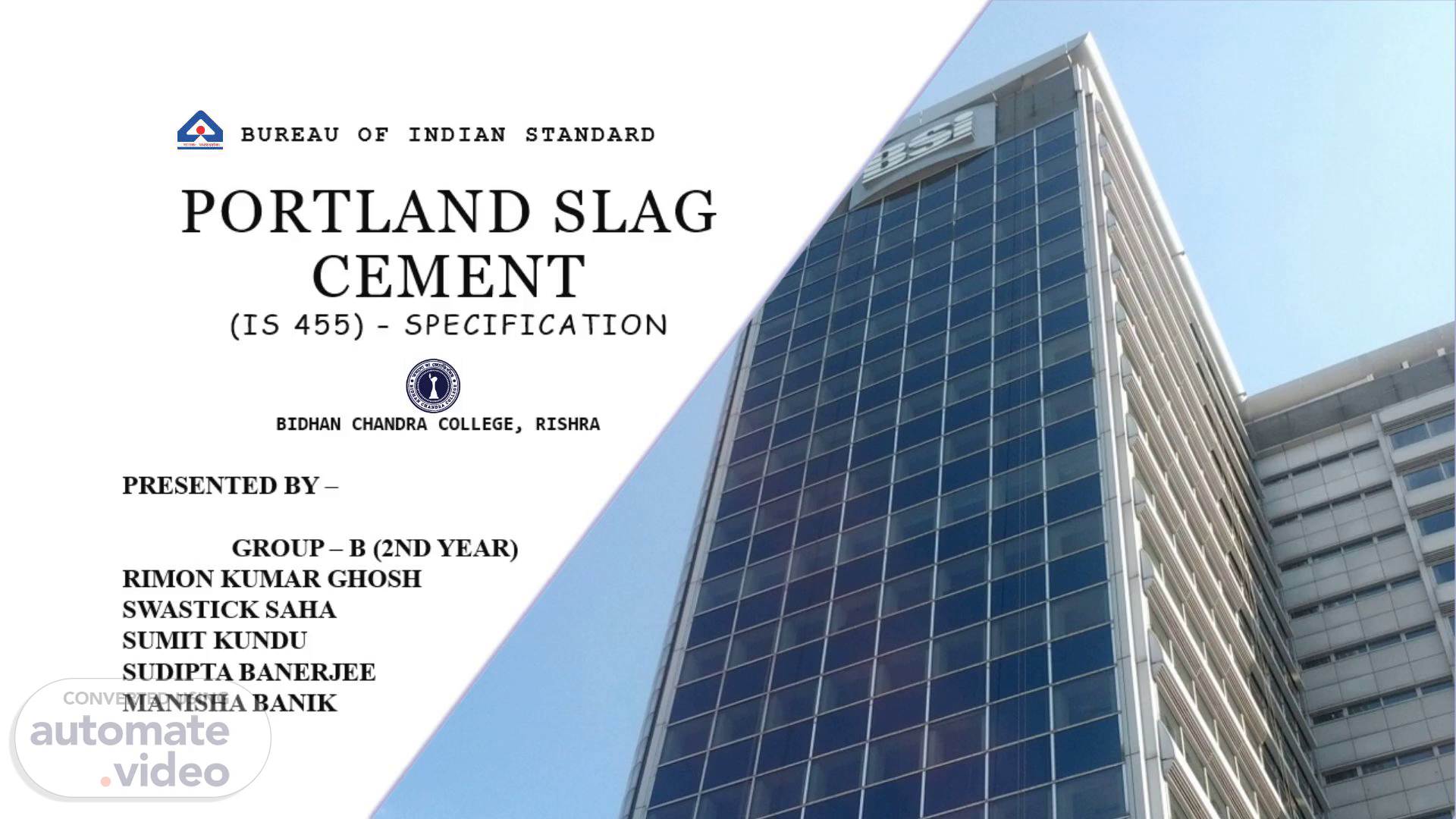
BUREAU OF INDIAN STANDARD PORTLAND Slag cement (is 455) – specification
Scene 1 (0s)
BUREAU OF INDIAN STANDARD PORTLAND Slag cement (is 455) – specification.
Scene 2 (11s)
introduction. Portland Slag Cement (PSC) is a type of cement that is made by combining Portland cement clinker, granulated blast furnace slag, and gypsum. The slag is a byproduct of the iron and steel industry, and it is ground into a fine powder before being added to the other ingredients. The mixture is then ground into a fine powder, and it is ready to be used to make concrete. PSC is used in a variety of applications, including: Concrete construction Dams Bridges Roads Buildings Marine structures.
Scene 3 (37s)
SCOPE. General Construction: Suitable for residential, commercial, and industrial projects. Concrete Structures: Commonly used in bridges, highways, tunnels, and dams. Road Construction: Ideal for pavements and other road components. Mass Concrete Works: Appropriate for large foundations and heavy-duty structures. Marine Structures: Resistant to sulfate attacks, suitable for harsh environments. Residential and Commercial Buildings: Comparable performance to ordinary Portland cement. High-Performance Concrete: Applied in structures requiring enhanced durability and reduced permeability..
Scene 4 (1m 3s)
reference. Components of Portland Slag Cement:. 3.
Scene 5 (1m 32s)
METERIALS. Clinker is the main component (used 45% - 50%) of ordinary Portland cement and is produced by heating a mixture of limestone, clay, and other raw materials to a high temperature in a kiln. It forms the basis for the hydraulic properties of the cement..
Scene 6 (2m 11s)
MAKING OF PORTLAND SLAG CEMENT. Manufacturing Of Portland Slag Cement (PSC):.
Scene 7 (2m 39s)
Tests for Portland slag cement. 6. Random Sampling Test Implement random sampling to avoid bias and ensure a fair representation of the entire cement lot. Standard Curing Time Test It will take recommended curing duration (commonly 30 – 600 minutes) to allow for sufficient strength development. Water Absorption Test The water absorption limit for PSC typically adheres to industry standards, with values commonly ranging between 3% and 5%..
Scene 8 (3m 13s)
Packaging OF PORTLAND SLAG CEMENT. Bag Material: PSC is typically packaged in durable, moisture-resistant bags to protect the cement from environmental conditions. Common bag materials include paper or woven polypropylene with a protective inner lining. Bag Weight: Bags of PSC are commonly available in standard weights, such as 50 kg or other specified amounts. The weight is labeled on the bag for easy identification. Labeling: The bag is prominently labeled with essential information, including the type of cement (Portland Slag Cement), brand name, manufacturer details, product specifications, and relevant certifications. Compliance with Standards: Packaging must comply with relevant industry standards to ensure the safe and secure transportation of Portland Slag Cement. Environmental Considerations: Some manufacturers may focus on sustainable packaging materials and practices to align with environmental standards. Protective Measures: Adequate protective measures, such as UV-resistant coatings or additional layers, may be incorporated into the packaging to shield the cement from sunlight and other environmental factors..
Scene 9 (3m 56s)
Identifying PSC : Visual Cues and Characteristics.
Scene 10 (4m 26s)
ADVANTAGES Durability: Enhanced resistance to chemical attacks and corrosion. Strength Development: Shows better long-term strength. Reduced Heat of Hydration: Prevents thermal cracking in large structures. Environmental Benefits: Recycles industrial by-products, reducing carbon footprint. Improved Workability: Easier to handle and place in construction. Cost Savings: May be more economical, with potential long-term savings..
Scene 11 (5m 1s)
TERMINOLOGY. Clinker: Basis for hydraulic properties. GBFS: Byproduct from blast furnace, enhances cementitious properties. Gypsum: Regulates setting time, prevents flash setting. Random Sampling Test: Avoids bias, ensures fair representation. Heat of Hydration Test: Measures heat release during cement hydration. Standard Curing Time Test: Determines recommended curing duration. Chemical Resistance Test: Evaluates resistance to chemicals. Water Absorption Test: Measures water absorption limit. Compressive Strength Test: Assesses compressive strength at specified durations. Visual Cues: concrete objects, pictures, symbols, or written words that provide a child with information about how to do a routine, activity, behavior, or skill..
Scene 12 (5m 33s)
11. [image]. CONCLUSION Portland slag cement is a versatile and sustainable cement type that offers superior performance and environmental benefits in various applications. It works synergistically with Portland cement and limestone to produce high-quality concrete that meets the demands of modern construction. PSC is a valuable resource that can help reduce the environmental impact of the cement industry and contribute to the circular economy.
Scene 13 (5m 51s)
THANK YOU.